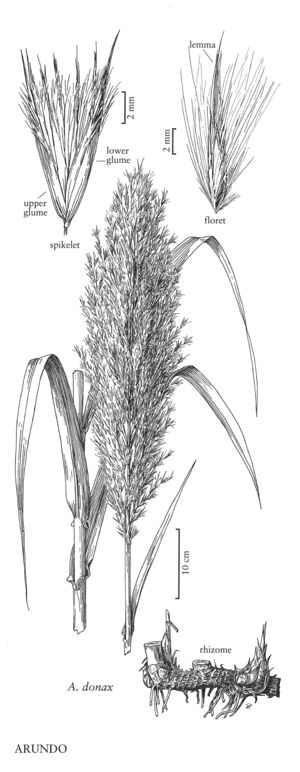Difference between revisions of "Arundo donax"
FNA>Volume Importer |
imported>Volume Importer |
||
| (8 intermediate revisions by 2 users not shown) | |||
| Line 4: | Line 4: | ||
|publications= | |publications= | ||
|common_names=Giant reed | |common_names=Giant reed | ||
| + | |special_status={{Treatment/ID/Special_status | ||
| + | |code=I | ||
| + | |label=Introduced | ||
| + | }} | ||
|basionyms= | |basionyms= | ||
|synonyms={{Treatment/ID/Synonym | |synonyms={{Treatment/ID/Synonym | ||
|name=Arundo donax var. versicolor | |name=Arundo donax var. versicolor | ||
| − | |authority= | + | |authority= |
| + | |rank=variety | ||
}} | }} | ||
|hierarchy=Poaceae;Poaceae subfam. Arundinoideae;Poaceae tribe Arundineae;Arundo;Arundo donax | |hierarchy=Poaceae;Poaceae subfam. Arundinoideae;Poaceae tribe Arundineae;Arundo;Arundo donax | ||
| Line 20: | Line 25: | ||
-->{{Treatment/Body | -->{{Treatment/Body | ||
|distribution=Del.;W.Va.;Pacific Islands (Hawaii);Fla.;Tex.;La.;Tenn.;N.C.;S.C.;Nev.;Va.;Calif.;Puerto Rico;Virgin Islands;Ala.;Ark.;Ill.;Ga.;Ariz.;N.Mex.;Md.;Okla.;Utah;Mo.;Kans.;Miss.;Ky. | |distribution=Del.;W.Va.;Pacific Islands (Hawaii);Fla.;Tex.;La.;Tenn.;N.C.;S.C.;Nev.;Va.;Calif.;Puerto Rico;Virgin Islands;Ala.;Ark.;Ill.;Ga.;Ariz.;N.Mex.;Md.;Okla.;Utah;Mo.;Kans.;Miss.;Ky. | ||
| − | |discussion=<p>Within the Flora region, Arundo donax grows in the southern half of the contiguous United States, being found along ditches, culverts, and roadsides where water accumulates. It has been used extensively as a windbreak, and planted for erosion control on wet dunes. It is also grown for the ornamental value of its tall, leafy culms and large panicles, but its tendency to spread is sometimes a disadvantage. Cultivars with striped or unusually wide leaves, e.g., 'Variegata' and 'Macrophylla', are of horticultural interest but do not merit taxonomic recognition.</p><!-- | + | |discussion=<p>Within the Flora region, <i>Arundo donax</i> grows in the southern half of the contiguous United States, being found along ditches, culverts, and roadsides where water accumulates. It has been used extensively as a windbreak, and planted for erosion control on wet dunes. It is also grown for the ornamental value of its tall, leafy culms and large panicles, but its tendency to spread is sometimes a disadvantage. Cultivars with striped or unusually wide leaves, e.g., 'Variegata' and 'Macrophylla', are of horticultural interest but do not merit taxonomic recognition.</p><!-- |
| − | --><p>Arundo donax has been used for thousands of years in making musical instruments, the stems being used for pipes and the tough inner rind for reeds in a wide variety of woodwind instruments. It is one of the species referred to as 'reed' in the Bible. It is still used in many parts of the world for house construction, lattice-work, mats, screens, stakes, walking sticks, and fishing poles.</p> | + | --><p><i>Arundo donax</i> has been used for thousands of years in making musical instruments, the stems being used for pipes and the tough inner rind for reeds in a wide variety of woodwind instruments. It is one of the species referred to as 'reed' in the Bible. It is still used in many parts of the world for house construction, lattice-work, mats, screens, stakes, walking sticks, and fishing poles.</p> |
|tables= | |tables= | ||
|references= | |references= | ||
| Line 30: | Line 35: | ||
-->{{#Taxon: | -->{{#Taxon: | ||
name=Arundo donax | name=Arundo donax | ||
| − | |||
|authority=L. | |authority=L. | ||
|rank=species | |rank=species | ||
| Line 37: | Line 41: | ||
|basionyms= | |basionyms= | ||
|family=Poaceae | |family=Poaceae | ||
| + | |illustrator=Linda A. Vorobik;Hana Pazdírková | ||
| + | |illustration copyright=Utah State University | ||
|distribution=Del.;W.Va.;Pacific Islands (Hawaii);Fla.;Tex.;La.;Tenn.;N.C.;S.C.;Nev.;Va.;Calif.;Puerto Rico;Virgin Islands;Ala.;Ark.;Ill.;Ga.;Ariz.;N.Mex.;Md.;Okla.;Utah;Mo.;Kans.;Miss.;Ky. | |distribution=Del.;W.Va.;Pacific Islands (Hawaii);Fla.;Tex.;La.;Tenn.;N.C.;S.C.;Nev.;Va.;Calif.;Puerto Rico;Virgin Islands;Ala.;Ark.;Ill.;Ga.;Ariz.;N.Mex.;Md.;Okla.;Utah;Mo.;Kans.;Miss.;Ky. | ||
|reference=None | |reference=None | ||
|publication title= | |publication title= | ||
|publication year= | |publication year= | ||
| − | |special status= | + | |special status=Introduced |
| − | |source xml=https:// | + | |source xml=https://bitbucket.org/aafc-mbb/fna-data-curation/src/200273ad09963decb8fc72550212de541d86569d/coarse_grained_fna_xml/V25/V25_24.xml |
|subfamily=Poaceae subfam. Arundinoideae | |subfamily=Poaceae subfam. Arundinoideae | ||
|tribe=Poaceae tribe Arundineae | |tribe=Poaceae tribe Arundineae | ||
Latest revision as of 18:58, 11 May 2021
Culms (2)3-10 m, in large tussocks or hedges. Leaves distichous; ligules 0.4-1 mm; blades 30-100 cm long, 2-7(9) cm wide, with a wedge-shaped, light to dark brown area at the base. Panicles 30-60 cm long, to 30 cm wide. Spikelets 10-15 mm, with 2-4 florets. Glumes subequal, as long as the spikelets, thin, brownish or purplish, 3-veined, long-acuminate; lemmas 8-12 mm, 3-5-veined, pilose, hairs 4-9 mm, apices bifid, midvein ending into a delicate awn; paleas 3-5 mm, pilose at the base; anthers 2-3 mm. Caryopses 3-4 mm, oblong, light brown. 2n = 24, 100, 110.
Distribution
Del., W.Va., Pacific Islands (Hawaii), Fla., Tex., La., Tenn., N.C., S.C., Nev., Va., Calif., Puerto Rico, Virgin Islands, Ala., Ark., Ill., Ga., Ariz., N.Mex., Md., Okla., Utah, Mo., Kans., Miss., Ky.
Discussion
Within the Flora region, Arundo donax grows in the southern half of the contiguous United States, being found along ditches, culverts, and roadsides where water accumulates. It has been used extensively as a windbreak, and planted for erosion control on wet dunes. It is also grown for the ornamental value of its tall, leafy culms and large panicles, but its tendency to spread is sometimes a disadvantage. Cultivars with striped or unusually wide leaves, e.g., 'Variegata' and 'Macrophylla', are of horticultural interest but do not merit taxonomic recognition.
Arundo donax has been used for thousands of years in making musical instruments, the stems being used for pipes and the tough inner rind for reeds in a wide variety of woodwind instruments. It is one of the species referred to as 'reed' in the Bible. It is still used in many parts of the world for house construction, lattice-work, mats, screens, stakes, walking sticks, and fishing poles.
Selected References
None.
